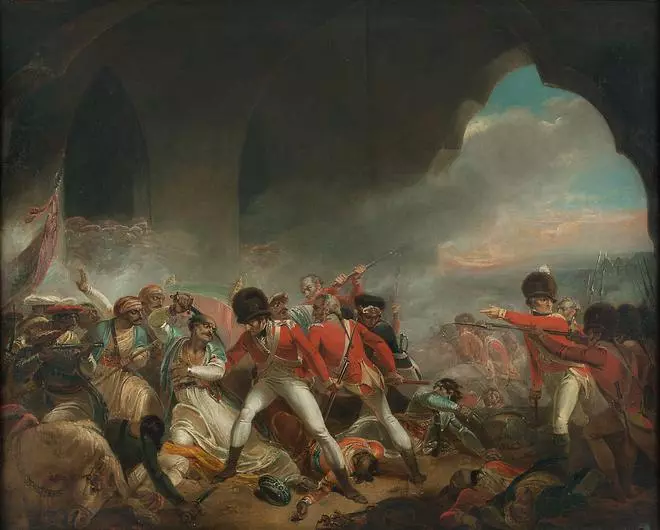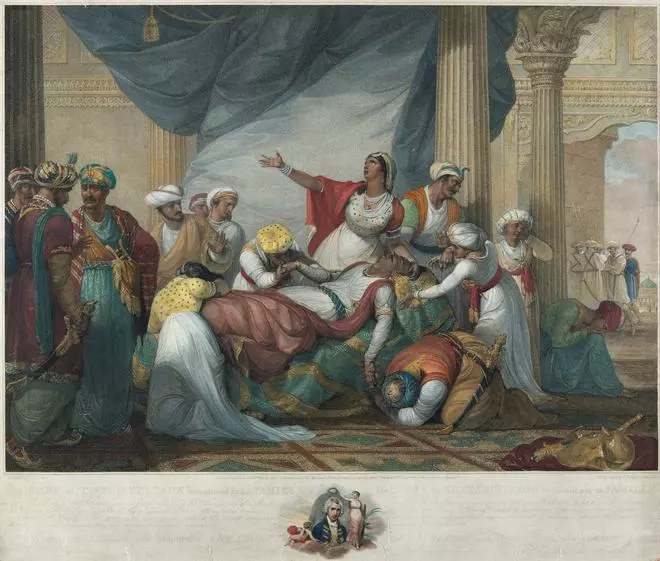
[ad_1]
The DAG exhibition urges viewers to assess the Mysore ruler’s importance afresh.
In 2015, Jnanpith awardee Girish Karnad said, “I feel that if Tipu Sultan was a Hindu and not Muslim, he would have attained the position in Karnataka that Shivaji Maharaj enjoys in Maharashtra.” Karnad made this comment during the first Tipu Jayanti celebrations held by the Siddaramaiah-led Congress government in November that year. The Bharatiya Janata Party boycotted the event: according to it, the 18th century ruler of Mysore is a “bigot” and a Muslim zealot. As protests broke out, two persons—a Hindu and a Muslim—died in Madikeri.
After toppling the Congress-Janata Dal (Secular) coalition government in 2019, when B.S. Yediyurappa became Chief Minister of a BJP government, the first decision he took was to cancel the celebrations in Karnataka. Subsequently, chapters in school textbooks hailing Tipu as one of India’s earliest freedom fighters were watered down.
Sifting through historical records helps us make an objective assessment and when it comes to Tipu, such documents are aplenty, even if most of them are by East India Company men, who fought him. An ongoing exhibition by art gallery DAG titled Tipu Sultan: Image & Distance (July 25-August 31) at The Claridges hotel in New Delhi adds another layer to the Tipu chronicle by bringing together artworks centred on him.
Also read:Tipu—fact & fiction
They reveal a great deal of things, but most important they show how the British viewed Tipu, who, along with his father, Hyder Ali, stood as a bulwark against the ambitions of the East India Company.
Colonial gaze
Hyder Ali (c. 1720-1782) and Tipu Sultan (1751-1799) fought four major battles, known as the Anglo-Mysore Wars, against the British from their base in south India, a region which broadly corresponds to modern southern Karnataka. While the Mysore rulers had the upper hand in first two wars (1767-69 and 1780-84), Tipu was defeated in the third and fourth wars (1789-92 and 1798-99). He died on the battlefield at the age of 48 on May 4, 1799, after his capital Srirangapatna was besieged by Company soldiers. It was a landmark victory for the British that left them free to expand their dominion in the south.

The Last Effort and Fall of Tippoo Sultaun (c. 1802) by Henry Singleton
As art historian Brian Allen says, “Episodes connected with the Anglo-Mysore wars provided the painter with more subject matter than any other topic in Anglo-Indian history.” Most of the artworks on display are from the last two battles and they indicate how the colonial gaze underlined British triumphs. “Bucking the trend of Indian works of art being exported abroad, we decided to bring this material to India, to display to Indian audiences,” says Ashish Anand, MD and CEO of DAG. “This led us to consider some further questions. What does Tipu Sultan mean to present-day Indians? What did he stand for? Some people idolise him while others are fiercely dismissive of his contribution. What cannot be disputed is that he was the most formidable foe the British faced in India. This exhibition explores how these images are interpreted in India today,” he adds.
Snatched away
The centrepiece is a panoramic print, stretching across nine feet, of a painting depicting the “Storming of Seringapatam”. The original, painted by Robert Ker Porter, was of gigantic proportions (21 feet high and 120 feet long) and was displayed in London from April 1800 to January 1801. The vivid painting evokes the grim mood of the battle along with the frenzy of the climactic charge as British soldiers clash with the Mysore army. Tipu is a minute turbaned figure in one corner: orderly lines of red and white liveried Company soldiers dominate the scene as they seize the ramparts of the Srirangapatna fort. Visible on the horizon are the twin minarets of a mosque and a temple.

The Body of Tippoo Sultaun Recognised by his Family (1801) by Henry Singleton
Other paintings that grab attention are the series of “hostage pictures”. With his defeat in the Third Anglo-Mysore War, Tipu not only lost half his territory but also had to suffer the ignominy of surrendering two of his sons as hostages to the British till the time he paid them Rs.3 crore. Painters Robert Home and Arthur William Devis were present in Mysore to record the episode, while Mather Brown and Henry Singleton in London relied on reports to convey the intensity of the moment in distant Mysore. Interestingly, this incident of unmatched cruelty on the part of the British is given a soft, paternal and benign glow in the paintings.
Also read:Tipu in Malabar
The artists were perhaps taking the lead from chroniclers like Alexander Dirom who wrote that on being received by Governor General Cornwallis, the faces of the two princes “brightened up” and “all the spectators were delighted to see that any fears they might have harboured were removed, and that they would soon be reconciled to the changed situation and their new friends.” Analysing this series of paintings, Giles Tillotson, the curator of the DAG show, writes: “The history painter sought a moment of moral power, and the ostensibly tender reception of the princes fitted that bill far better than the violence that prompted it.”
Actual violence
Then there is a set of pictures on the siege of Srirangapatna in 1799. Apart from Porter’s magnum opus, works of artists such as Thomas Stothard and Singleton are also included in this series. Stothard’s painting titled The Assault of Seringapatam shows the soldiers and sepoys of the East India Company fording the Cauvery and beginning to attack the walls of the fort. Here the events are taking place at night rather than in the afternoon, when they actually took place, and this heightens the drama. These paintings, Tillotson writes, are the “first works by British artists to focus on the actual violence of the Mysore Wars. And they mark “a new departure in the representation of war in European art.”

The Storming of Seringapatam (triptych, 1802) by Robert Ker Porter
Moving on, there are the “Body Pictures”, which depict Tipu Sultan as he falls in battle and his body is later discovered, as imagined by Singleton, Porter and David Wilkie. Wilkie’s painting, General Sir David Baird Discovering the Body of the Sultaun Tippoo Sahib, was commissioned by the widow of David Baird in 1834, years after Tipu’s death. Tillotson points to the grilled window beneath Baird’s feet, and says it is “a reminder to the audience that Baird had been held prisoner at Srirangapatna for four years by Hyder Ali after the Battle of Pollilur [during the Second Anglo-Mysore War]”.
Another striking work, Singleton’s The Body of Tippoo Sultaun Recognised by his Family, breaches the zenana or the women’s quarters, framing the lamenting mourners in a neoclassical mode.
Then there are the portraits. An engraving of Tipu Sultan made for the Western audience a few years after his death shows him in profile, in a resplendent white turban with an aigrette of precious stones. He has a bullish neck, heavy jowls, and a pencil-thin moustache twirled across his cheek.
Life in Mysore
Maps and watercolours pertaining to the wars and scenes of Mysore by Robert Home, R.H. Colebrooke, Francis Swain Ward, Thomas Daniell, James Hunter—all were either professional painters or artistic soldiers of the East India Company—are good aids to understanding Tipu’s kingdom. A tiny display case in a corner of the gallery holds a medal awarded to participants of the final Anglo-Mysore War: it depicts a British lion subduing a Mysore tiger.
Also read: Striking legacy
DAG’s exhibition is one of a kind in collecting a vast treasure trove of visual material relating to Tipu. The show also makes a statement, asking viewers to assess the sovereign afresh. The real challenge will be to bring the exhibition to Bengaluru, which teems with Tipu admirers as well as rabid critics.
Historian Caleb Simmons offers a nuanced assessment of Tipu Sultan in Devotional Sovereignty: Kingship and Religion in India: “The narrow focus on religious identity in these debates masks the complexities of Tipu Sultan’s understanding of religion, sovereignty, and warfare during his rule by anachronistically projecting a modern European understanding of religious exclusivity onto the ruler. Tipu Sultan, like many Indian rulers before him, occupied multiple religious identities and could simultaneously be Muslim, have a Hindu guru, patronize Hindu temples, and wage holy war.” In an essay included in the catalogue, Janaki Nair, one of the foremost historians of Tipu Sultan’s reign, says that it is imperative “to leave binaries behind and strive for non-sectarian histories of conquest and conflict in India”.
[ad_2]
Source_link